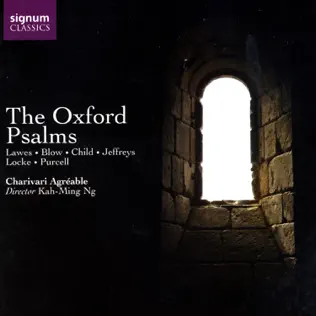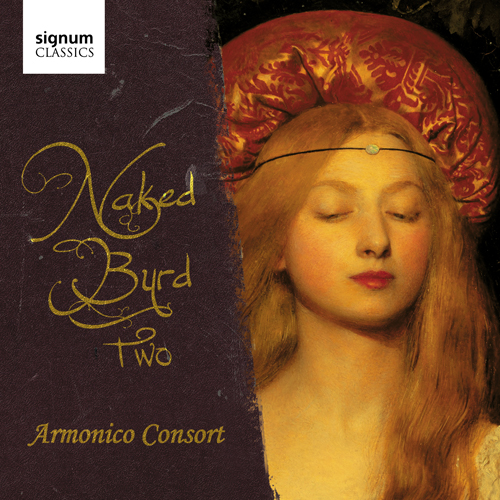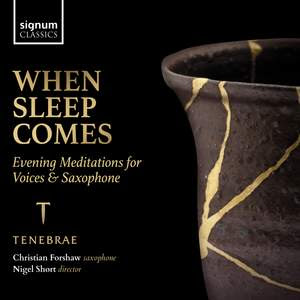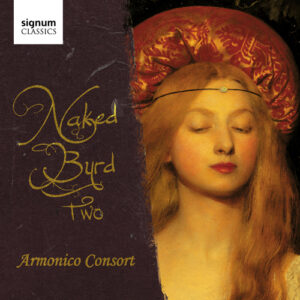Program: #22-41 Air Date: Oct 10, 2022
To listen to this show, you must first LOG IN. If you have already logged in, but you are still seeing this message, please SUBSCRIBE or UPGRADE your subscriber level today.
The Oxford Psalms, Naked Byrd Part 2, and the latest from the Tenebrae Ensemble, "When Sleep Comes."
I. The Oxford Psalms: Anthems for Three Men and a Band from 17th Century England (Charivari Agreeable/Kah-Ming Ng). Signum CD SIGCD093.




1. The Lamentation: O Lord, in thee William Lawes
2. Psalm L1/2: Cast me not, Lord William Lawes
3. In the beginning, O Lord Matthew Locke
4. Blest be those sweet Regions Jeremiah Clarke
5. Miserere, from Parthenia in-violata Anonymous
6. Psalm XVIII/1: O God my strength and fortitude William Lawes
7. Psalm VI: Lord, in thy wrath William Lawes
8. As on Euphrates? shady banks John Blow
9. A Ground for ye Harpsichord Anonymous/
10. The First Set of Psalmes of III Voyces (Extracts) William Child
11. Since God so tender Henry Purcell
12. Divisions in F Frances Withy
13. Praise the Lord, O my soule George Jeffreys
14. Blessed is he that considerith the poor Henry Purcell
15. Voluntary Albertus Bryne
16. Let god arise Matthew Locke
17. The humble suite of a sinner: O Lord, of whom… William Lawes
18. Gloria Patri et Filio William Lawes
II. Naked Byrd Two (Armonico Consort/Christopher Monks). Signum CD SIGCD235.

Naked Byrd Two was recorded in the real tennis court in the village of Moreton Morrell, Warwickshire – a building with a most amazing acoustic – in February 2010 and, along with the earlier album Naked Byrd, completes the recording of a concert which has fast become the calling card of Armonico Consort. It is an indulgence of what may arguably be described as some of the greatest choral music ever written.
From Music Web International: This is the second CD to be inspired by Armonico Consort’s ‘Naked Byrd’ concert programme, which, to quote the Signum publicity material, ‘features music by Tavener, Purcell, Barber and Byrd, composers who wore their hearts on their sleeves, and whose art saw their emotions laid bare, in an atmospheric concert where magical musical moments are intertwined with sublime passages of plainchant and violin improvisation’ It’s similar in manner to Volume 1 which I reviewed in May 2010 – see review.
Let me say at once that, having cut though the publicity hype, I found the whole of this programme as beautiful and as excellently sung as the first. It also introduces the listener to some unfamiliar music, but let me also get two small complaints out of the way. The first is that 53 minutes is rather short value for a full-price CD, however good.
Secondly, as was the case with Volume 1, someone picking up the CD in a browser might buy it on impulse under the impression that the music is all or mostly by Byrd, when, in fact, there is only one 4-minute item by him. I’m afraid that the titles of Naked Byrd 1 and 2 do rather beg the question.
What we do have more than compensates – a very wide-ranging and eclectic programme of some of the most beautiful music ever composed, from the opening Salve Regina, attributed to the 11th-century composer Hermannus Contractus, via the two works by the wonderful Abbess Hildegard, to whose music I could listen all night, through the renaissance and baroque, Samuel Barber’s own arrangement of his Adagio and two by-now familiar John Tavener works, to three new compositions here receiving their first outings.
One of these new works is a re-working of an old one by the Consort’s artistic director Christopher Monks, revisiting the same piece from Thomas Tallis’s English settings in Archbishop Parker’s Psalter which Vaughan Williams employed for his Fantasia on a Theme by Thomas Tallis. The result is not quite as magical as that VW composition, partly because Monks stays closer to the original – Tallis was stuck with setting some fairly banal English words and had to set them in a fairly limited manner, unable to make settings of English his own in quite the same way that his younger contemporary Byrd was able to do. Nevertheless, the Phrygian mode of the original is haunting and Monks’ reworking is impressive. I don’t always react favourably to this kind of reinterpretation of earlier music – Jan Garbarek’s realisations on ECM, Officum Novum* and its predecessors, leave me feeling profoundly depressed – but I found Kelly McCusker’s violin weaving around Anna Sanderson’s voice here very moving. As with most of the music here, both ancient and modern, from the soaring opening Salve Regina onwards, the epithet ‘ethereal’ is highly appropriate.
Even if you have the complete Byrd four-part Mass from which the Agnus Dei (tr.12) is excerpted or the complete Victoria Requiem whence Versa est (tr.10) is derived, you shouldn’t feel short-changed. You may, however, note that, as on Volume 1, slower tempi than usual are adopted for these and for most of the medieval and renaissance pieces, even by comparison with the Tallis Scholars, themselves no speed merchants.
1. Salve Regina Hermann Contractus
2. The Spirit of Tallis Thomas Tallis, arr. Christopher Monks
3. Agnus Dei (from Adagio for Strings) Samuel Barber
4. Funeral Ikos John Tavener
5. Hear my Prayer, O Lord Henry Purcell
6. Spiritus Sanctus Vivificans Hildegard of Bingen
7. Never Seek to Tell Thy Love Jonathan Roberts
8. Crucifixus Antonio Lotti
9. O Virtus Sapientiae Hildegard of Bingen
10. Versa Est (Requiem) Tomas Luis de Victoria
11. Strengthen ye the weak hands David Buckley
12. Agnus Dei from 4 part mass William Byrd
13. The Lamb John Tavener
III. When Sleep Comes (Tenebrae/Christian Forshaw, saxophone/Nigel Short). Signum SIGCD708.

This isn’t quite a concept album, and it certainly isn’t designed to make you nod off: instead it’s a series of deeply beautiful meditations, some of which are on nocturnal themes, blending voice and saxophone sensationally lovely ways to create a think of beauty.
I hadn’t come across composer and saxophonist Christian Forshaw before, but I really liked what I heard of him here, be that in his compositions, his arrangements or his playing. Tenebrae and Nigel Short are, of course, a known quantity, and a fantastic one at that. The booklet doesn’t specify how many singers they used for this recording, but it doesn’t sound like many, and a photo of what (I assume) was one of the recording sessions suggests it’s only about half a dozen.
The disc is divided between original music by Forshaw and his arrangements of music by other composers. The original music is solid, direct and very listenable-to: his setting of the In Paradisum from the service of committal sets the text with plainsong directness, while the soprano sounds like an additional member of chorus rather than an added spiritual presence. In fact, the delight of much of the disc is that it’s sometimes impossible to tell whether you’re listening to the saxophone or a soprano voice. That’s also delightfully the case in his evening chant and in his beautifully simple setting of Psalm 121. A line he sets in Renouncement gives the disc its title, though it’s the track I enjoyed least, perhaps because of its complexity: elsewhere the real appeal of the disc is its simplicity, something Forshaw restores in his silky, transluscent setting of the evening prayer Te lucis ante terminum.
In the music by other composers, it’s difficult to ignore the ghost of Jan Garbarek and the Hilliard Ensemble in their famous (and famously successful) Officium of 1994. But while there are undeniable echoes to and fro, Tenebrae and Forshaw put their own mark on what they do. Gibbon’s famous Drop, drop slow tears is an utterly delectable way to begin the disc. Gentle vocalises begin and end the anthem as the saxophone soars above them, and the text itself is enunciated with crystalline clarity, close up to the microphone, creating a spellbinding atmosphere of focus and concentration, behind which the saxophone spirals gently skywards. Here, and frequently elsewhere, the saxophone feels like a heavenly body connecting we humans with the divine, spiralling upwards like an angel or a dove to bring the voices of the choir closer to those of God himself. You’ll hear this effect most powerfully in the earliest track on the disc, Hildegard of Bingen’s O vos imitatores, but it happens again and again. In Tallis’ O Nata Lux the saxophone plays a very minor role in the text-setting, but adds palpable colour, and there is a gentle shading of beauty to the great hymn Abide with me.
There are several tracks on this disc, such as in Tallis’ Sancte Deus or Victoria’s Reproaches, where the saxophone doesn’t play at all. That at least means that Tenebrae are left along to sing with the beauteous, unadulterated transparency for which they have justifiably become world famous, but it made me wonder why they’d included those tracks when the whole point of the disc is to hear the blend with the saxophone.
That’s what you’ll come back to this disc for. This is one I think I’ll be dipping into again and again, and not just on sleepless nights.
Simon Thompson
Composer Info
William Lawes, Matthew Locke, Jeremiah Clarke, John Blow, Christopher Simpson, William Child, Henry Purcell, Frances Withy, George Jeffreys, Albertus Bryne, Hermann Contractus, Samuel Barber, John Tavener, Hildegard of Bingen, Jonathan Roberts, Antonio Lotti, Christopher Monks, Tomas Luis de Victoria, David Buckley, William Byrd, Orlando Gibbons, Christian Forshaw, Thomas Tallis, Owain Park, Henry F. Lyte , William H. Monk, Antoine Brumel
CD Info
Signum CD SIGCD093, Signum CD SIGCD235, Signum SIGCD708
